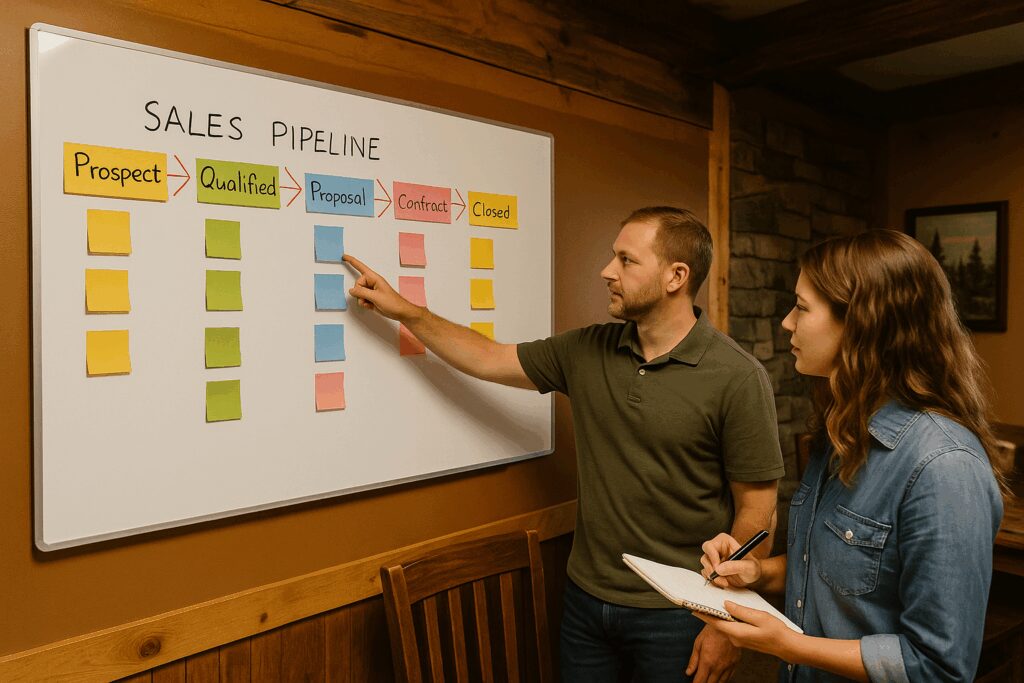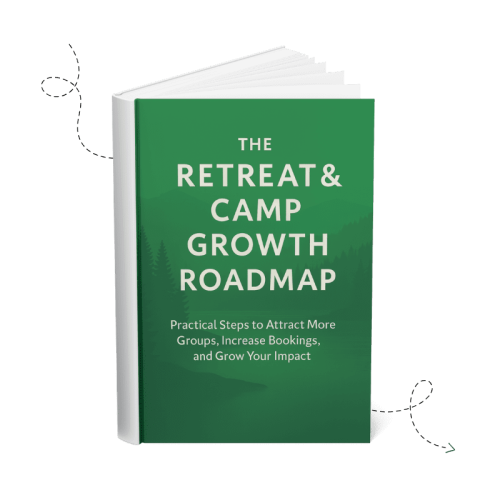Retreat & Camp Growth Roadmap Step: Strengthen Sales Process
Introduction
Your retreat center is getting inquiries…but are you consistently turning enough of them into bookings? Without a clear sales process, even the most promising leads can fall through the cracks. Strengthening your sales process brings clarity, reduces missed opportunities, and frees your staff to focus on building meaningful relationships instead of chasing paperwork.
By aligning your tools and team around a streamlined system, you create a more professional and responsive guest experience. This article walks through the core elements of this step and how it can help your ministry steward every inquiry well. In the sections ahead, you’ll see how a few key systems can transform your inquiry process into a reliable path toward more bookings.
Why This Step Matters
Most retreat centers and camps care deeply about their mission and want to serve as many groups as possible. Often, the individuals responsible for handling inquiries and guiding guests are passionate and mission-minded, but may lack formal training in sales or experience managing a sales process. In many cases, leadership teams are also not equipped to mature or manage the sales function. The result is that many lose potential bookings simply because of inconsistent follow-up or clunky communication systems.
When your sales process is unclear or manual, your team is forced to play catch-up:
- Inquiries pile up in inboxes.
- Follow-ups are forgotten or delayed.
- Meeting logistics become a time-consuming burden.
- Leadership lacks visibility into future revenue.
- There are no clear conversion metrics to guide forecasting or evaluate performance.
A strong sales process doesn’t just make life easier for your team—it honors the people God is bringing to your ministry. It shows that you value their time and are prepared to serve them well.
From a stewardship standpoint, it also ensures that the marketing dollars and efforts you invest are not wasted. Every lead gets the attention it deserves, and your team has the tools to guide guests toward a confident decision.
Is This a Step You Need to Focus on Right Now?
Ask yourself:
- Are we consistently responding to inquiries in a timely and organized way?
- Is our communication with prospects well-managed and centralized?
- Do staff have clarity and confidence around who to follow up with and when?
- Is meeting scheduling simple and streamlined for our team and guests?
- Do I have a clear view of where each lead stands in our booking process?
If you answered “no” to any of these, this step can help you bring greater clarity, alignment, and impact to your outreach.
Putting This Step Into Practice
The “Strengthen Sales Process” step brings together three foundational focus areas to help your team respond faster, stay organized, and guide guests through the journey from inquiry to booking.
Unify Lead Communications
When communication with guests is scattered across personal inboxes, sticky notes, and text messages, things fall through the cracks. By unifying all lead communications into a single platform—email, text, and phone calls—you simplify the follow-up process for your team.
This not only creates a smoother experience for guests, but also gives your staff the ability to see every conversation in one place. It becomes easier to know who followed up, what was said, and what comes next. For a deeper dive into this focus area, explore the full blog article linked below. You can also download the worksheet to begin applying the concepts to your own process.
Read the Full Article: How Unified Lead Communications Can Transform Retreat & Camp Outreach
📥 Download the Unified Lead Communications Worksheet
Unifying communications is the first and most foundational step in building a clear sales process. Once your team is equipped with a centralized view of guest conversations, it’s much easier to implement structured follow-up systems and move leads forward.

Implement a Sales Pipeline
A sales pipeline is a visual system that tracks where each inquiry stands in the journey from first contact to confirmed booking. Without one, it’s easy to lose momentum or miss key follow-ups.
With a well-defined pipeline in place, your team gains the structure it needs to stay proactive and responsive. This enables you to:
- Know what stage each lead is in.
- See what actions are needed to move them forward.
- Identify bottlenecks in the process.
This clarity helps retreat centers prioritize wisely, follow up more effectively, and create a more intentional guest experience. For a detailed walkthrough of how to implement a pipeline, be sure to check out the full blog article. You can also download the worksheet to start mapping your own sales pipeline today.
Read the Full Article: Implementing a Retreat Sales Pipeline to Drive Retreat Booking Growth for Your Camp
📥 Download the Sales Pipeline Mapping Worksheet
With a communication foundation in place, adding a pipeline gives structure to your follow-up process. It helps your team see the big picture, identify gaps, and move prospects forward with confidence—setting the stage for automation tools that reduce friction even further.

Automate Meeting Scheduling
One of the biggest points of friction in the sales process is scheduling meetings. Every back-and-forth email is a chance for momentum to stall. By using online scheduling tools, you empower guests to book instantly at their convenience.
Automated confirmations, reminders, and calendar syncing reduce no-shows and staff burden. Multiple calendar types (for tours, planning calls, or intro chats) make it easy to serve each type of prospect well.
Even better, when this system is integrated into your retreat center’s CRM, it becomes part of a seamless sales process that supports both your guests and your team. To explore the full strategy behind automating meeting scheduling, check out the complete blog article below. You can also download the worksheet to walk through key decisions and action steps for your center.
Read the Full Article: Automate Meeting Scheduling to Streamline Your Retreat Bookings
📥 Download the Automate Meeting Scheduling Worksheet
When scheduling is simplified, the final hurdle in your sales process becomes much easier to overcome. With communication, pipeline, and scheduling systems in place, your team is equipped to confidently nurture leads from inquiry to booking.

Mini Case Study
One Christian retreat center we worked with had passionate staff, consistent inquiries, and a strong desire to grow—but their internal systems weren’t keeping up. Communication happened through a mix of inboxes and sticky notes, meetings were scheduled manually, and no one had a clear view of where each lead stood.
As a result, some groups never received a follow-up. Others had to reschedule meetings multiple times. They also missed rebooking opportunities due to inconsistent follow-up, and occasionally lost future bookings when groups who had previously inquired about specific dates were not contacted after those dates opened up. Staff felt stretched thin, and the process became a source of frustration rather than joy.
By implementing LeadHub CRM to unify communication, build a visual sales pipeline, and automate meeting scheduling, they were able to:
- Reduce the time spent coordinating meetings.
- Improve response times and consistency.
- Ensure every inquiry and rebooking opportunity was followed up.
- Capture additional bookings by tracking inquiries for previously unavailable dates.
- Free up staff to focus on ministry, not admin.
The transformation wasn’t about fancy tech—it was about creating a clear, guest-centered process that reflected their mission and strengthened their ability to serve. With their new sales system in place, they improved initial booking rates, increased rebooking rates, and unlocked additional growth through better visibility and follow-up. Because LeadHub tracked all inquiries—even those that didn’t initially book—they were able to re-engage interested groups when spots opened up later.
Putting It All Together
Strengthening your sales process is one of the most strategic things you can do to grow your ministry without overwhelming your team. By aligning your tools, clarifying your process, and supporting your staff with automation, you build a system that works—even when you’re busy.
Here are a few key takeaways:
- Centralize lead communications so your team always knows who said what, and when.
- Build a sales pipeline to visualize and manage every inquiry from start to finish.
- Automate meeting scheduling to remove friction and save time for both staff and guests.
- Use templates and workflows to ensure every lead receives timely, thoughtful follow-up.
- Track performance so you can make data-driven decisions to improve your process.
- Don’t wait for perfection—start with what you have and improve over time.
When your sales process is strong, your retreat center becomes more responsive, more professional, and more effective at turning interest into impact. You don’t need a large team or expensive software—just a commitment to steward your inquiries well and a willingness to build step by step.
Ready to Take the Next Step?
Strengthening your sales process helps you make the most of every inquiry, stewarding opportunities with clarity and care.
If you found this helpful, here are four great next steps to continue your journey:
🧭 Move to the Next Step: Activate Lead Nurturing
Learn how to use automation to engage new leads and move them closer to booking.
[Read the Activate Lead Nurturing Step Article]
📘 Download the Retreat & Camp Growth Roadmap eBook
Get the full 3-stage system we use to help retreat centers and camps grow with clarity and purpose.
[Download the eBook]
🌱 Learn More About How We Help Retreat Centers & Camps
We’re a Christian-owned digital marketing agency that helps retreat centers and camps grow attendance, bookings, and impact through practical strategies rooted in clarity and stewardship.
[See How We Can Help]
🤝 Schedule a Free Discovery Call
Want help applying this to your unique situation? Let’s talk. We’ll explore where you are now, where you want to go, and how to take the next faithful step.
[Book a Discovery Call]
You don’t have to figure this out alone. Let’s build something meaningful—together.
Frequently Asked Questions
1. What is a sales pipeline and why do retreat centers need one?
A sales pipeline is a visual process that helps your team track each inquiry from initial contact to final booking. It provides clarity, improves follow-up, and helps your team stay focused and aligned.
2. Can these tools integrate with our existing systems?
Yes. Tools like LeadHub CRM are designed to integrate with Google Workspace, Office365, Zoom, and more—making it easy to fit within your existing workflow.
3. How do automated reminders help our team?
Automated reminders reduce no-shows, improve attendance rates for scheduled meetings, and help staff focus on meaningful follow-up instead of sending repetitive emails.
4. What are the main benefits of unifying lead communications?
When all calls, texts, and emails are centralized, your team avoids duplication and dropped conversations. It also improves guest experience and team collaboration.
5. Is it hard to implement a sales process like this?
Not at all. Many retreat centers start small—adding just one piece, like a scheduling tool or communication platform—and build from there. You don’t need to do everything at once.
6. Can these strategies support both small and large retreat centers?
Absolutely. Whether you’re managing a few inquiries a week or dozens, these practices scale to fit your needs and free up valuable time.
7. How does this help with christian camp marketing or retreat marketing specifically?
A stronger sales process helps ensure that your christian camp marketing efforts don’t go to waste. Every lead is nurtured, followed up, and moved closer to a booking.
8. What if we already have a system in place?
This process can enhance your existing system by filling in the gaps—especially if you’re still relying on manual follow-up or disconnected tools.
9. Do we need special software for this to work?
Not necessarily. While we recommend tools like LeadHub CRM for full integration, many retreat centers begin with basic tools like Calendly or shared spreadsheets and grow from there.
10. How do I know if we’re improving?
Once your sales pipeline is in place, you can track key metrics like response time, meeting no-show rates, and conversion rates. This data helps you adjust and improve over time.





